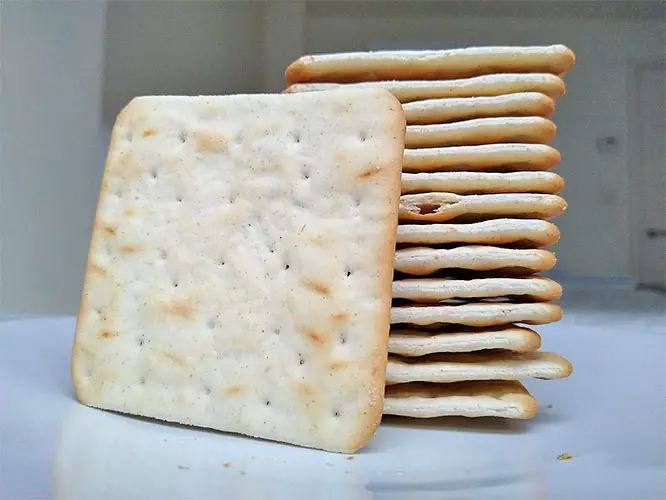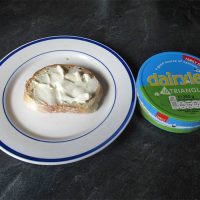Recently updated on May 21st, 2024 at 08:47 pm
When it comes to snacks like cream crackers, the big question is: Are they good for you, or are they another “bad” food to avoid? As a parent, I’m all about finding snacks that are not just tasty but also healthy, especially for my toddler.
So, I decided to dig deep into the world of cream crackers to find out. Trust me, the findings might make you rethink that bread vs. crackers debate you have every time you’re at the grocery store. Ready to crack the code on cream crackers? Let’s dive in.

What’s Really in Your Cream Crackers?
Diving into the list of ingredients in cream crackers, you’d notice it’s a relatively straightforward line-up: Wheat Flour, Calcium, Iron, Niacin, Thiamin, Vegetable Oil (Palm), Salt, Raising Agent (Sodium Bicarbonate), and Yeast.
Key Points:
- No Added Sugar & Egg-Free: Suitable for specific dietary needs.
- Palm Oil: Often avoided due to environmental concerns.
- White Processed Flour: Not very nutritious, more details in the next section.
Why Are They Called Cream Crackers?
By now, you might be wondering: “Why the word ‘cream’ in cream crackers when there’s no cream in them?” A fair question! The term ‘cream’ in cream crackers doesn’t refer to the dairy product but is thought to come from the “creaming” method used during production.
Breaking Down the Nutrition in Cream Crackers
Let’s delve into the nutritional aspects of cream crackers. For this analysis, we’re focusing on Jacobs Cream Crackers, the leading brand in this category. Keep in mind that many supermarkets also offer similar options in terms of nutritional content.
Each 8g cracker from Jacobs contains:
- Calories: 35 (Four crackers = 140 calories; comparable to a slice of white bread)
- Fat: 1.1g
- Carbs: 5.4g (Not suitable for low-carb diets)
- Fibre: 0.2g (Low in fibre; not very filling)
- Protein: 0.8g
- Salt: 0.1g (they are not excessively salty)
These crackers are low in fibre, so they might not be very filling. They’re also not suitable for low-carb diets due to their carb content.
Adding cheese (about 100 calories) or butter (around 36 calories per teaspoon) can significantly increase the calorie count. Keep these factors in mind if you’re monitoring your diet.

Are Cream Crackers a Good Choice for a Snack?
From my perspective, cream crackers have their pros and cons:
- Pros:
- Low in calories
- No added sugar
- Cons:
- Low in fibre and protein
- Not very nutritious
- Moderate carb content
- Contains palm oil, which may be a concern for some
I find them to be a basic, somewhat bland snack that isn’t very filling on their own. I often pair them with other foods.
While they’re not the most nutritious option out there, they aren’t the worst either. Enjoying them in moderation as part of a balanced diet seems like a reasonable approach. But if you’re on the hunt for a more nutrient-dense snack, there are better options to explore.
Frequently Asked Questions
Are Cream Crackers Bad for Cholesterol?
Cream crackers aren’t especially high in fats that would raise your cholesterol levels. So, they’re not bad for your cholesterol, but they also won’t help to lower it. If you’re aiming to reduce bad cholesterol, your best bet is to eat more fruits, vegetables, and other foods known to improve cholesterol levels.
Are Cream Crackers Suitable During Pregnancy?
Cream crackers are low in sugar and fairly simple in terms of ingredients, making them a reasonable snacking option during pregnancy. However, they don’t provide essential nutrients, so they shouldn’t replace more nutritious options.
Is It Safe for Babies and Toddlers to Eat Cream Crackers?
Cream crackers are low in sugar, which is beneficial for young children. However, they are also not nutrient-dense, so they should only be a small part of a varied diet for babies and toddlers.
Are Cream Crackers the Same as Saltines?
While similar, cream crackers and saltines are not identical. Saltines are generally saltier and may have a slightly different texture. They also differ in terms of ingredients and nutritional profile.
Are Cream Crackers Fattening?
With 35 calories per cracker, they’re not particularly calorie-dense. However, it’s important to consider the quantity consumed; eating four cream crackers will bring you to 140 calories, roughly equivalent to a slice of white bread.
The calorie count can climb even higher if you’re adding toppings like cheese or butter. So, while cream crackers themselves aren’t inherently fattening, the overall caloric intake can add up quickly if you’re snacking on them in large quantities. Moderation is key.
Do Cream Crackers Fit into a Low FODMAP Diet?
Cream crackers contain wheat, a potential high-FODMAP ingredient. Those following a low FODMAP diet may want to consider other options.
How Do Cream Crackers Compare to Bread, Nutritionally Speaking?
If you’re wondering whether to reach for cream crackers or a slice of bread, it really boils down to what you’re after nutrition-wise. Cream crackers have fewer calories, which is great if you’re counting those.
But if you’re looking for more fiber, a slice of whole-grain bread has got cream crackers beat. So, it’s a bit of a toss-up. Want fewer calories? Go for the crackers. Craving more fiber? Pick the bread. Simple as that!
Are Cream Crackers Good for Weight Loss?
At 35 calories per cracker, cream crackers could fit into a weight-loss plan if you have them in moderation. However, they’re not very filling or rich in nutrients.
If you’re trying to lose weight, it might be better to choose snacks that are more filling and nutritious, so you’re less tempted to keep eating. Cream crackers are okay in a pinch, but they’re not the best option for regular snacking if you’re looking to lose weight.
Are Cream Crackers Suitable for Diabetics?
Four cream crackers have about 21.6g of carbohydrates, which is a moderate amount. If you’re managing diabetes, it’s crucial to monitor your carb intake carefully.
Cream crackers can be part of your diet, but it’s best to consult with your healthcare provider for personalized advice on whether they fit into your specific dietary plan for managing blood sugar.
Can Cream Crackers Cause Constipation?
Given their low fiber content, eating them in large quantities without sufficient water and other sources of fiber could potentially contribute to constipation.
Can Cream Crackers Cause Heartburn?
There’s nothing in the ingredients list that specifically flags them as a common cause of heartburn, but individual reactions can vary.
Can Cream Crackers Cause Wind?
They’re not particularly high in the kinds of carbohydrates that are typically associated with increased gas. However, individual tolerance levels can vary.



